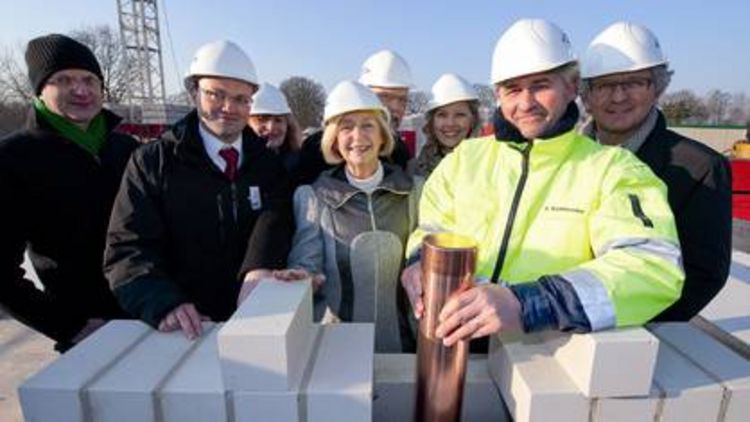The University of Oldenburg is expanding: At the Wechloy campus a new building which will house the Neurosensorics and Safety-Critical Systems Research Centres is under construction. The main focus: medical technologies and human-machine communication.
The cornerstone ceremony for the new building, known for short as NeSSy, took place on January 31st in the presence of Prof. Dr. Johanna Wanka, Minister for Science and Culture of the state of Lower Saxony, Prof. Dr. Gerd Schwandner, Mayor of Oldenburg, and numerous guests of honour.
Johanna Wanka, Minister of Lower Saxony said: "The NeSSy research building is an important investment for Oldenburg as a centre of knowledge and for the state of Lower Saxony. Through the close interlocking of life sciences and technological innovations we are supporting the field of neurosensorics and enhancing our research profile, also as regards international competitors."
Th new research building, which covers 2,000 square metres, will provide optimal working conditions for approximately 80 members of staff. University President Prof. Dr. Babette Simon is convinced: "Here, parallel to the 'classic' faculty and subject structures, a joint building for the two nationally and internationally recognised research areas neurosensorics and safety-critical systems is under construction, which will create excellent conditions for outstanding research." She added that NeSSy would also be of key importance for the European Medical School Oldenburg-Groningen (EMS), saying that neurosensorics formed a central pillar for the planned new school of medicine.
In the course of the nationwide competition for the university building, the German Science Council expressed its approval of the project. The advisory body noted that Oldenburg had already established itself nationally and internationally as a pre-eminent centre of competence in the field of hearing aid systems. It added that the research on safety features for embedded systems was also of major and international import and the two fields of research were highly integrated at a national and European level.
The two research areas are represented by medical physicist Prof. Dr. Birger Kollmeier, neurobiologist Prof. Dr. Reto Weiler and computer scientist Prof. Dr. Werner Damm. Birger Kollmeier is among other things head of the Medical Physics section and spokesman for the Centre for Hearing Research and the HörTech Center of Competence. Reto Weiler, managing director of the Neurosensors Research Centre, leads the Neurobiology Working Group. Werner Damm, director of the Safety-Critical Systems Research Centre, is also spokesman for the Transregional Collaborative Research Center "Automatic Verification and Analysis of Complex Systems" (AVACS).
At the new NeSSy building, the two research centres Neurosensorics and Safety-Critical Systems will concentrate on advancing interdisciplinary basic research and applied research and promoting communication among scientists in these fields, with the aid of a conference centre to be located within the building. Their work will focus on innovations in medical technology and human-machine communication. Half of the building's floorspace will be taken up by laboratories: acoustics/hearing laboratories, a virtual reality/usability laboratory and neurophysiology labs for magnetic resonance tomography, Magnetoencephalography and imaging technologies. The building will house four working groups from the two research centres: "Medical Physics", "Signal Processing", a neuropsychology group and an engineering working group.
The Stuttgart-based architects Heinle, Wischer und Partner designed the new building. The total cost including the initial fixtures, fittings and furnishings is estimated at approximately 15 million euros, half of which is being supplied by the federal government and half by the state of Lower Saxony. The building is expected to be completed in June 2013.

